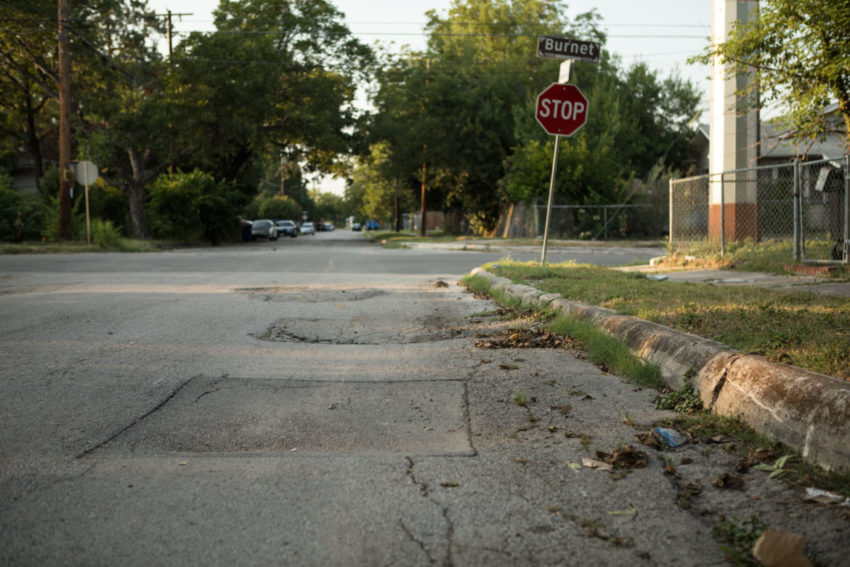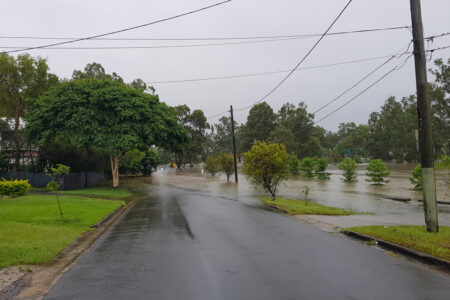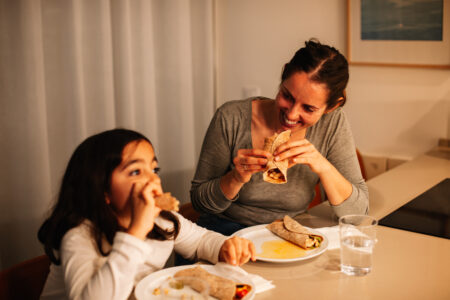
Share On Social!
This is part of our Active Spaces & Latino Kids: A Research Review »
How sidewalks and the built environment impact physical activity
Characteristics of neighborhoods and the built environment—man-made features in the community, such as sidewalks, streets, buildings, parks and playgrounds—may prevent Latino children from using available physical activity sites.46–59
These include:
- availability and accessibility of competitive transport alternatives and infrastructures (e.g., transit, sidewalks, bike lanes; availability of local government and highway funds for sidewalks and bike lanes;
- frequency of non-motorized transportation (variation by trip purpose and/or trip distance);
- presence of integration between residential and commercial land use in dense population areas;
- presence of protective social factors and absence of social disorder;
- presence of attractions and comforts as well as absence of physical disorder;
- availability and accessibility of facilities or natural features for activity; and
- availability of local government funds for parks and recreation facilities; and presence of community-wide campaigns to increase active living.
In a survey of parents and adolescents from three U.S. metropolitan areas (10% of whom were Latino), proximity to home and easy access to the site by walking/biking were significantly associated with more frequent use of the sites by children and adolescents. Higher perceived traffic safety, better pedestrian infrastructure, and low crime were also significantly associated with more frequent walking/biking to a recreation site.48
Proximity to schools was also found to be associated with increased physical activity in a study of 3,451 adolescents (34.1% of whom were Latino) who responded to the 2005 California Health Interview Survey.60
Adolescents who lived less than 3,200 meters (about 2 miles) from school were more likely to walk, bike, or skateboard to school than those who lived farther away. The authors recommend building schools near residential areas with the highest concentration of students to encourage more walking and biking to school.
The built environment in Texas colonias
Another study investigated the relationship between the built environment and physical activity in 14 unincorporated settlements, called colonias, in Hidalgo County, Texas.61,62
After conducting focus groups with resident children (ages 8-13) researchers found that certain features of the built environment were related to physical activity levels in children.
During the focus group sessions, children noted several factors that could improve their levels of physical activity, including the construction of walking areas, parks, sports and recreation areas and basketball courts, installation of swings and street lights, and increased police presence in the area. The children also reported that unpleasant neighborhood conditions, such as trash-filled and muddy streets, bad outdoor odors, dilapidated playgrounds, unleashed dogs, gangs, and speeding cars prohibited them from being active.
Data from the street audits of 125 colonia streets found that only 1 percent had sidewalks or crosswalk signs, and only 9 percent had speed bumps. Other features that were uncommon were “Children at Play” signs, shoulders, stop signs, and speed limit signs.
Walkability and aesthetic issues
One study assessed the walkability and safety around elementary schools in 73 predominantly poor and Latino neighborhoods in Austin, Texas.63
Although the neighborhoods were found to have an adequate number of sidewalks, the street-level walkability of those sidewalks was low, due to poor visual quality, lack of physical amenities, poor maintenance, and low levels of perceived safety.
Other studies report similar findings, that low-income and Latino neighborhoods often lack well-maintained yards, appealing scenery, and historic, cultural or architectural buildings, contributing to poor aesthetic quality.64–66
Neighborhood crime influences active transport for Latinos
A study investigating physical activity and outdoor recreation among 390 Latino children in the South Lawndale community of Chicago (83% Latino; 92% Mexican-American), also referred to as Little Village, found that Latino children in the area are often exposed to violent crime in the neighborhood, as a witness and/or victim,67 and their fear of crime negatively impacts their levels of physical activity and outdoor recreation.
The participants reported decreased use of parks or locations requiring them to cross gang boundaries and less participation in after-dark activities, with some children not participating in any physical activity due to safety concerns.
Other research from U.S. urban areas has also documented that Latino children are more likely to live in unsafe areas.63
More from our Active Spaces & Latino Kids: A Research Review »
- Introduction & Methods
- Key Research Finding: Access to active spaces
- Key Research Finding: Shared use agreements
- Key Research Finding: Unpleasant neighborhood characteristics (this section)
- Key Research Finding: Park maintenance and safe streets
- Key Research Finding: Marketing of physical activity
- Policy Implications
- Future Research Needs
References for this section »
(46) Pikora, T.; Giles-Corti, B.; Bull, F.; Jamrozik, K.; Donovan, R. Developing a Framework for Assessment of the Environmental Determinants of Walking and Cycling. Soc. Sci. Med. 2003, 56 (8), 1693–1703.
(47) Brennan Ramirez, L. K.; Hoehner, C. M.; Brownson, R. C.; Cook, R.; Orleans, C. T.; Hollander, M.; Barker, D. C.; Bors, P.; Ewing, R.; Killingsworth, R.; et al. Indicators of Activity-Friendly Communities. An Evidence-Based Consensus Process. Am. J. Prev. Med. 2006, 31 (6), 515–524.
(48) Grow, H. M.; Saelens, B. E.; Kerr, J.; Durant, N. H.; Norman, G. J.; Sallis, J. F. Where Are Youth Active? Roles of Proximity, Active Transport, and Built Environment. Med. Sci. Sports Exerc. 2008, 40 (12), 2071–2079.
(49) Brownson, R. C.; Hoehner, C. M.; Day, K.; Forsyth, A.; Sallis, J. F. Measuring the Built Environment for Physical Activity. State of the Science. Am. J. Prev. Med. 2009, 36 (4 SUPPL.), S99–S123.e12.
(50) Sugiyama, T.; Howard, N. J.; Paquet, C.; Coffee, N. T.; Taylor, A. W.; Daniel, M. Do Relationships between Environmental Attributes and Recreational Walking Vary according to Area-Level Socioeconomic Status? J. Urban Heal. Bull. New York Acad. Med. 2015, 92 (2), 253–264.
(51) Bruton, C.; Floyd, M. Disparities in Built and Natural Features of Urban Parks: Comparisons by Neighborhood Level Race/Ethnicity and Income. J. Urban Heal. 2014, 91 (5), 894–907.
(52) Silver, D.; Giorgio, M.; Mijanovich, T. Utilization Patterns and Perceptions of Playground Users in New York City. J. Community Health 2014, 39 (2), 363–371.
(53) Rothman, L.; Buliung, R.; Macarthur, C.; To, T.; Howard, A. Walking and Child Pedestrian Injury: A Systematic Review of Built Environment Correlates of Safe Walking. Inj. Prev. 2013.
(54) Curriero, F. C.; James, N. T.; Shields, T. M.; Gouvis Roman, C.; Furr-Holden, C. D. M.; Cooley-Strickland, M.; Pollack, K. M. Exploring Walking Path Quality as a Factor for Urban Elementary School Children’s Active Transport to School. J. Phys. Act. Health 2013, 10 (3), 323–334.
(55) Tappe, K. a; Glanz, K.; Sallis, J. F.; Zhou, C.; Saelens, B. E. Children’s Physical Activity and Parents’ Perception of the Neighborhood Environment: Neighborhood Impact on Kids Study. Int. J. Behav. Nutr. Phys. Act. 2013, 10 (1), 39.
(56) Hannay, J.; Dudley, R.; Milan, S.; Leibovitz, P. K. Combining Photovoice and Focus Groups Engaging Latina Teens in Community Assessment. Am. J. Prev. Med. 2013, 44 (3 SUPPL. 3), S215–S224.
(57) Torres, M. E.; Meetze, E. G.; Smithwick-Leone, J. Latina Voices in Childhood Obesity a Pilot Study Using Photovoice in South Carolina. Am. J. Prev. Med. 2013, 44 (3), S225–S231.
(58) Allen, E. M.; Hill, A. L.; Tranter, E.; Sheehan, K. M. Playground Safety and Quality in Chicago. Pediatrics 2013, 131 (2), 233–241.
(59) Sallis, J. F.; Spoon, C.; Cavill, N.; Engelberg, J. K.; Gebel, K.; Parker, M.; Thornton, C. M.; Lou, D.; Wilson, A. L.; Cutter, C. L.; et al. Co-Benefits of Designing Communities for Active Living: An Exploration of Literature. Int. J. Behav. Nutr. Phys. Act. 2015, 12 (1), 30.
(60) Babey, S. H.; Hastert, T. A.; Huang, W.; Brown, E. R. Sociodemographic, Family, and Environmental Factors Associated with Active Commuting to School among US Adolescents. J. Public Health Policy 2009, S203–S220.
(61) Mier, N. Assessing the built environment in Colonias to influence policy promoting physical activity in Mexican-American children and families. Available at: https://salud-america.org/sites/salud-america/files/grantee-research/mier2011.pdf. (accessed Feb 19, 2015).
(62) Mier, N.; Lee, C.; Smith, M. L.; Wang, X.; Irizarry, D.; Avila-Rodriguez, E. H.; Trevino, L.; Ory, M. G. Mexican-American Children’s Perspectives: Neighborhood Characteristics and Physical Activity in Texas-Mexico Border Colonias. J. Environ. Health 2013, 76 (3), 8–16.
(63) Zhu, X.; Lee, C. Walkability and Safety Around Elementary Schools. Economic and Ethnic Disparities. Am. J. Prev. Med. 2008, 34 (4), 282–290.
(64) Brownson, R. C.; Baker, E. a; Housemann, R. a; Brennan, L. K.; Bacak, S. J. Environmental and Policy Determinants of Physical Activity in the United States. Am. J. Public Health 2001, 91 (12), 1995–2003.
(65) Franzini, L.; Taylor, W.; Elliott, M. N.; Cuccaro, P.; Tortolero, S. R.; Gilliland, M. J.; Grunbaum, J.; Schuster, M. A. Neighborhood Characteristics Favorable to Outdoor Physical Activity: Disparities by Socioeconomic and Racial/ethnic Composition. Health Place 2010, 16 (2), 267–274.
(66) Neckerman, K. M.; Lovasi, G. S.; Davies, S.; Purciel, M.; Quinn, J.; Feder, E.; Raghunath, N.; Wasserman, B.; Rundle, A. Disparities in Urban Neighborhood Conditions: Evidence from GIS Measures and Field Observation in New York City. J. Public Health Policy 2009, 30 Suppl 1, S264–S285.
(67) Stodolska, M. Crime, physical Activity and outdoor recreation among Latino adolescents. Available at: http://www.salud-america.org/grantees5.html#stodolska (accessed Dec 20, 2012).
Explore More:
Healthy Neighborhoods & CommunitiesBy The Numbers
1
Supermarket
for every Latino neighborhood, compared to 3 for every non-Latino neighborhood



